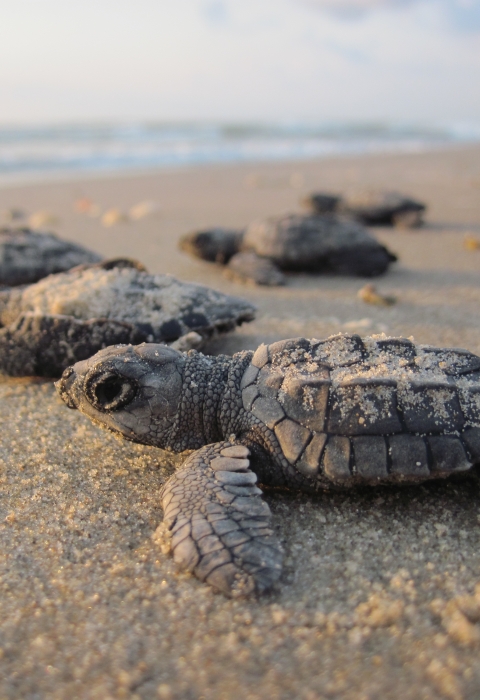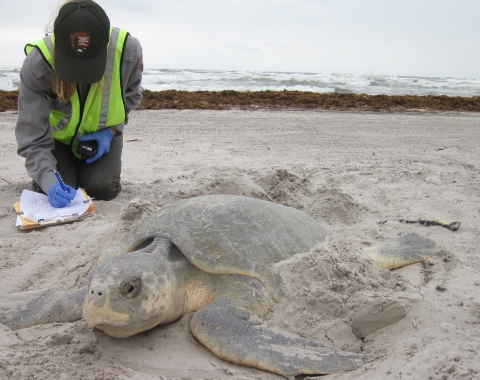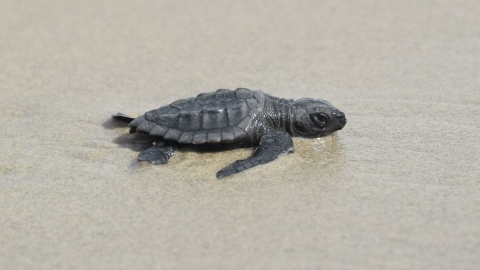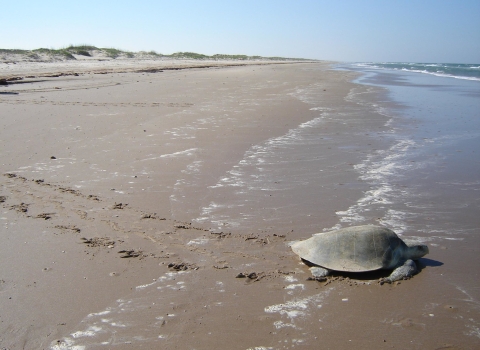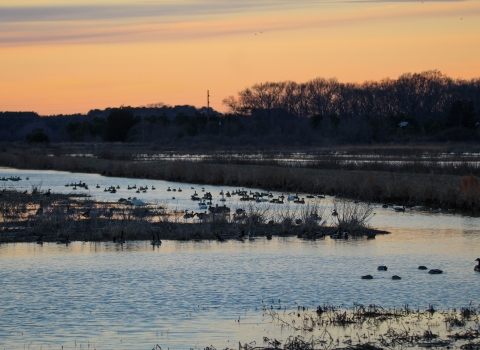With nesting season beginning in late March, the U.S. Fish and Wildlife Service urges Texas beach visitors to stay vigilant, drive slowly and avoid disturbing nest sites to help protect imperiled sea turtles, including the endangered Kemp's ridley and the threatened loggerhead and green sea turtles.
“Sea turtles face numerous threats during nesting season,” said Mary Kay Skoruppa, U.S. Fish and Wildlife Service Sea Turtle Coordinator for Texas. “Early detection of nests and any emerging hatchlings allows trained professionals to respond and increase their chance of survival. By reporting your sightings promptly from March through September, you can directly contribute to the success of these nesting attempts and help recover sea turtle populations on the Texas coast.”
If a nesting sea turtle is seen, the Service advises visitors in Texas to quickly report the event by calling 1-866-TURTLE-5 (1-866-887-8535). After observing and reporting a sea turtle, visitors are asked to remain at the site until a biologist arrives. If it is not possible to stay until a biologist arrives, visitors are asked to carefully mark the site by laying pieces of beach debris, such as pieces of wood or other debris, in a large circle around the nest area so biologists will be able to find the nest when they arrive.
Nesting sea turtles are vulnerable to threats like predators and vehicle traffic on the beach. In particular, Kemp’s ridley sea turtles nest during the day making them especially vulnerable. Sea turtles enter a “trance-like” state while nesting and cannot move to avoid hazards. Additionally, these threatened and endangered sea turtles blend into the sand and sometimes choose to nest in vehicular tire ruts, putting them at risk of being crushed and killed by passing cars.
“Driving slowly on the beach during nesting season is crucial,” Skoruppa said. “Female sea turtles coming ashore to lay their eggs and hatchlings emerging from the sand are incredibly vulnerable to accidental collisions with vehicles. By driving slowly and staying alert, you can play a vital role in protecting these imperiled animals and allowing future generations to witness the wonder of sea turtles nesting on our shores.'"
To help ensure the survival of nesting sea turtles and eggs, biologists and volunteers will patrol Texas beaches throughout the nesting season. The Service, along with the National Park Service, Texas A&M University at Galveston, the University of Texas Marine Science Institute, Sea Turtle, Inc., Texas Parks and Wildlife Department, and Turtle Island Restoration Network will be working together to coordinate a response when a nesting sea turtle, tracks, or nest is found.
The Kemp’s ridley sea turtle is the smallest species of sea turtle, measuring about two feet long and weighing up to 100 pounds. Kemp’s ridley sea turtles usually come ashore during the daylight hours to lay eggs in the sand. The green sea turtle and loggerhead sea turtle also nest along the Texas coast but in smaller numbers than the Kemp’s ridley, and unlike the Kemp’s ridley, usually come ashore at night.
This year marks 46 years (1978-2024) of bi-national Kemp’s ridley sea turtle conservation. In 1947, an estimated 40,000 Kemp’s ridley turtles nested on one stretch of beach near Rancho Nuevo, Mexico. This was the only known nesting site at that time. Over the next four decades, the species suffered a devastating decline with a 99.4 percent reduction in numbers of nests. In response to the dramatic loss of this species, the Service and its partner agencies launched a cooperative international project in 1978. The project focuses on nest protection efforts in the U.S. and Mexico, implementing regulations requiring the use of turtle excluder devices on commercial shrimp boats, and establishing a second nesting colony of Kemp’s ridley sea turtles at Padre Island National Seashore, Texas, where historical nesting had been documented.
Cooperative efforts continue to help the Kemp’s ridley sea turtle population. In 2023, 256 Kemp’s ridley nests were found in Texas – the largest number recorded in Texas since 1978 was in 2017, when 353 nests were documented. The Kemp’s ridley sea turtle remains one of the most endangered species of sea turtle in the world; therefore, bi-national conservation efforts must continue to fully recover the species.
